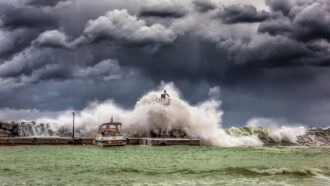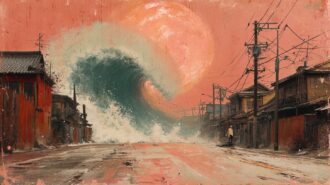At the end of December 2004, near the Indian Ocean island of Sumatra, one of the strongest earthquakes of the last half century occurred. The consequences were catastrophic: the shifting of the lithospheric plates created a huge fault and a large amount of water rose from the ocean floor, which at a speed of one kilometer per hour began to move rapidly across the Indian Ocean.
As a result, thirteen countries were affected, about one million people were left without a “roof over their heads,” and more than two hundred thousand people were killed or missing. The disaster was the worst in the history of mankind.
Tsunamis are long and high waves resulting from the abrupt shifting of the lithospheric plates of the ocean floor during submarine or coastal earthquakes (the waves are 150 to 300 km long). Unlike ordinary waves, which appear as a result of strong winds on the water surface (e.g. storms), a tsunami wave affects water from the bottom to the ocean surface, causing even low elevated water to often lead to catastrophes.
Interestingly, these waves are not dangerous to ships in the ocean at that time: most of the stirred-up water is in the depth of several kilometers, therefore, the height of waves above the water surface is from 0.1 to 5 meters. Approaching the coast, the rear part of the wave catches up with the front part, which at this time slightly slows down, grows to a height of 10 to 50 meters (the deeper the ocean, the bigger the wave) and a crest appears on it.
It should be kept in mind that the greatest speed of the impending wave develops in the Pacific Ocean (it ranges from 650 to 800 km/h). As for the average speed of most waves, it ranges from 400 to 500 km/h, but there were recorded cases when they accelerated to the speed of a thousand kilometers (the speed usually increases after the wave passes over the deep water trench).
Before it hits the coast, the water suddenly and quickly moves away from the shoreline, exposing the bottom (the farther it has retreated, the higher the wave will be). If people are not aware of the approaching elements, instead of getting as far away from the shore as possible, on the contrary, they run to collect shells or pick up fish that did not have time to go into the sea. And just a few minutes later the wave, arriving here at high speed, does not leave them a chance to escape.
It should be kept in mind that if a wave arrives on the coast from the opposite side of the ocean, the water does not always recede.
Eventually, the enormous mass of water floods the entire coastline and goes inland for a distance of 2 to 4 kilometers, destroying buildings, roads, piers and leading to the death of people and animals. Before the berm, clearing the way for the water, there is always an air blast wave that literally explodes the buildings and structures in its path.
Interestingly, this deadly phenomenon of nature consists of several waves, and the first wave is not the largest: it only wetters the coast, reducing the resistance for the following waves, which often do not come at once, and at intervals of two to three hours. The fatal mistake people make is to return to shore after the first swell has left.
Causes of formation
One of the main causes of shifting of the lithospheric plates (in 85% of cases) is underwater earthquakes, during which one part of the bottom rises and the other part sinks. As a consequence, the ocean surface begins to wobble vertically, trying to return to its original level, forming waves. It is worth noting that underwater earthquakes do not always generate tsunamis: only those where the source is located a short distance from the ocean floor, and the shaking was at least seven points.
The causes of tsunamis are quite different. The main ones include underwater landslides, which, depending on the steepness of the continental slope, can travel enormous distances – from 4 to 11 km strictly vertical (depending on the depth of the ocean or gorge) and up to 2.5 km if the surface is slightly inclined.
Large waves can cause huge objects fallen into the water – rocks or blocks of ice. For example, the largest tsunami in the world, over 500 meters high, was recorded in the state of Lituya, Alaska, when a strong earthquake caused a landslide and 30 million cubic meters of rocks and ice to fall from the mountains into the bay.


